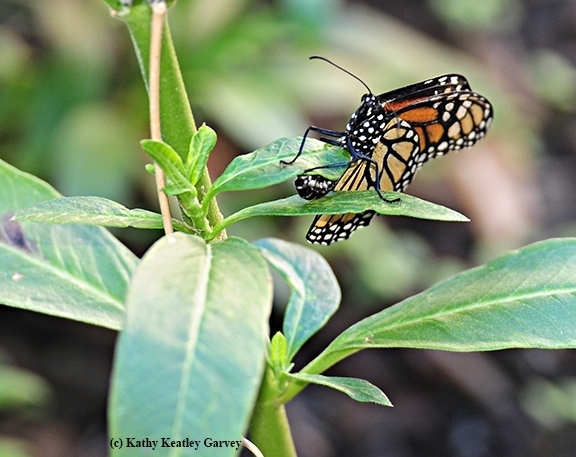
Apparently so, from personal observation.
Over the years, we've grown multiple species of milkweed in our pollinator garden in Vacaville, Calif. We give them a choice. The species include:
- Narrow-leafed milkweed, Asclepias fascicularis
- Showy milkweed, A. speciosa
- Pleurisy root, A. tuberosa
- Tropical milkweed, A. curassavica
- Hairy balls or balloonplant, Gomphocarpus physocarpus
Which species do they prefer? Tropical milkweed, hands down. But it's a plant that's become highly controversial in California. Friends unfriend friends, and the unfriended lash out with how "bad" tropical milkweed is and how "uneducated" the messenger is. "Don't you know about Ophryocystis elektroscirrha (OE)?" they ask. "How dare you plant tropical milkweed? Yank it out!"
Meanwhile, the monarchs keep monarching. And we keep observing them.
Consider the male monarch spotted lying in the middle of a residential street in west Vacaville the morning of Jan. 3. It was there despite the rain, the cold and the passing cars. What will happen to it? Will it find a mate? Will its mate be able to find a milkweed to deposit her eggs? She certainly won't find native milkweed, such as A. fascicularis and A. speciosa, but she might find A. curassavica.
If. She. Is. Lucky.
Mona Miller, administrator of the educational Facebook page, Creating Habitat for Butterflies, Moths and Pollinators, recently shared a post that should be "food for thought" (for us) and that should result in "more food" (milkweed) for the monarchs. Her Facebook page focuses on "the preservation and protection of North American butterflies, moths and pollinators, particularly the Monarch butterfly."
"All milkweeds get Ophryocystis elektroscirrha (OE)," Miller wrote. "There are native milkweeds that are viable in the fall and winter. Tropical milkweed, due to their high level of toxins (cardenolides), are very medicinal. Monarch females choose tropical milkweeds over less toxic native plants to self-medicate. In October 2022, there was a discussion on the Monarch Watch email list. Dr. (Orley "Chip") Taylor (founder and director of Monarch Watch and a professor in the Department of Ecology and Evolutionary Biology at the University of Kansas) said that tropical milkweed does not stop the migration. He said more native and tropical milkweed should be planted. He said the more milkweed that is available the less spores will be left on all milkweeds. Fewer milkweeds leave monarchs visiting available milkweeds and leaving more spores. You can read the discussion here, there are several posts: https://lists.ku.edu/pip.../dplex-l/2022-October/012192.html."
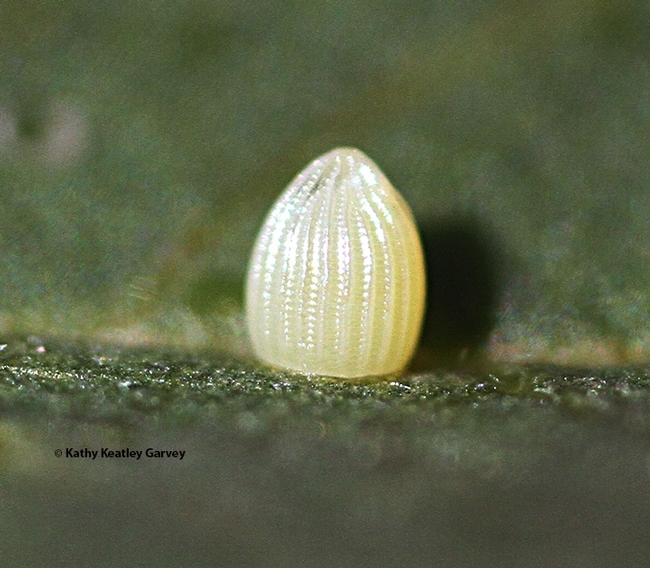
"Actually, the best strategy is to plant more milkweeds, both native and tropical," Professor Taylor wrote, explaining that "First, the interactions between monarchs, milkweed and O.E. are frequency and density dependent. What this means is that spore loads on foliage are dependent on the abundance of milkweed relative to the number of ovipositing females. The O.E. infection rate is a function of this dynamic. Second, because of these relationships, O.E. cycles. That is, it increases and then declines only to increase again. There is a seasonal pattern to these cycles with low rates in the spring and higher rates about 3-4 generations. Third, the interactions that contribute to cycling involve spatial relationships that include distances between resources (milkweed patches) and the search capabilities of the butterflies. There is a time component as well."
"Here is the scenario that could play out from San Diego to Ventura counties and parts of Marin as well," Taylor wrote. "Due to warmer conditions more and more native milkweeds (mostly fascicularis) remain green during the winter. This appears to be happening over a broad area. With the sale of tropical milkweed (hereafter TM) being prohibited and homeowners being discouraged from growing TM, what is the likely outcome? With fewer milkweeds overall, the O.E. spore count will go up on both native and TM. OE will become more common rather than less. Further, the reduced distribution of milkweeds will reduce the opportunity for O.E. to cycle. Cycling depends on part of the milkweed distribution being relatively free of spores for the monarch population to recover. Overall, there will be fewer butterflies surviving the winter and therefore a lower starting population in the spring. If that happens, there will be fewer monarchs through the entire season. So, instead of leading to lower O.E. and more butterflies, the elimination of TM is likely to reduce the monarch population--in effect taking the butterflies away from the people. Again, in addition to cutting back TM from time to time to reduce O.E., an alternative solution is to grow TM and to see that it is hyper-dispersed in gardens, etc. through the 5-county area. The same strategy would involve A. fascicularis and other native milkweeds."
"Some of the reaction to TM is simply based on the notion that it is non-native," Taylor wrote. "We can agree on that point. However, it does not naturalize and therefore is not invasive. Our gardens are filled with such plants. TM supports populations of monarchs as far south as Peru and in most, if not all, places where monarchs have been introduced. Also, since this species flowers nearly continuously through the growing season, it is a source of nectar for a large number of pollinating species. TM supports monarchs--full stop! Let's learn to live with it. More milkweeds equal more monarchs and less O.E. overall."
Taylor went on to say that TM does not cause monarchs to break diapause and become reproductive. "Dingle suggests that it is temperature that causes monarchs to break diapause and that is exactly what I have been saying for years. Hormone production is a function of temperature--head temperatures--and not contact with plants. The major driver in the West has been and will continue to be weather/climate. It starts with the conditions that determine the size and distribution of the overwintering female numbers and their reproductive success."
However, the California Department of Food and Agriculture (CDFA), influenced by conservation groups, has categorized A. curassavica as "a noxious weed," and county agricultural commissioners have banned the sale of the plant in nurseries in Marin, Contra Costa, San Mateo and Ventura counties.
Professor Dingle bears to differ. "No one should rush out and pull out their tropical milkweed as it would be a waste of time and effort," he says. "Nurseries should also be able to continue to sell it." He points out:
- "There is not enough tropical milkweed planted to have much influence (see the amount of A. syriaca and A. fascicularis throughout the American west not to mention various other species like A. erosa, cordifolia, californica, etc.) Yes, there are parasites on A. curassavica as there are on ALL milkweeds."
- "There are populations of monarchs that are doing just fine feeding exclusively on A. curassavica (e.g. on many Pacific Islands, such as Guam where I have studied them.
- "Migration and the diapause that accompanies it in the fall are determined by shortening photoperiod and temperature (warm temps can override short days hence the issue with climate change). There is no significant influence of food plant."
UC Davis distinguished professor Art Shapiro, who has monitored butterfly populations in central California since 1972, says the "anti-curassavica propaganda is total hogwash. I have been saying so for years."
Curious, isn't it, that a plant can be so controversial? Four states, California, Arizona, New Mexico and Texas, border Mexico. On the California side, inches away from the Mexican border, tropical milkweed is considered a "noxious weed" per the CDFA definition. On the other side, in Mexico, it's simply a great host plant for monarchs.
What does 2023 hold for the iconic monarch and its host plants? For one thing, more scientific research is needed.
Attached Images:
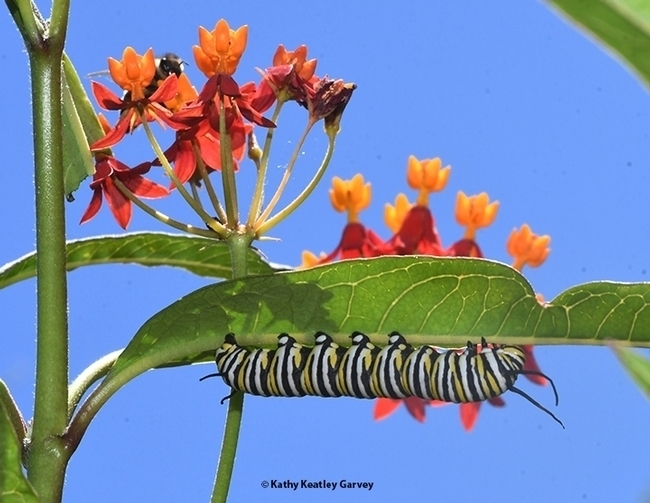
A monarch caterpillar feeding on tropical milkweed, Asclepias curassavica, in Vacaville, Calif. (Photo by Kathy Keatley Garvey)
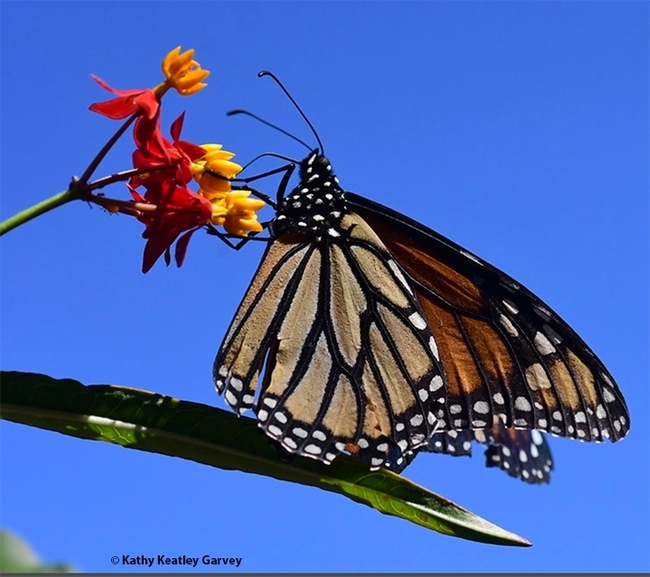
A monarch nectaring on tropical milkweed, Asclepias curassavica, in Vacaville, Calif. (Photo by Kathy Keatley Garvey)
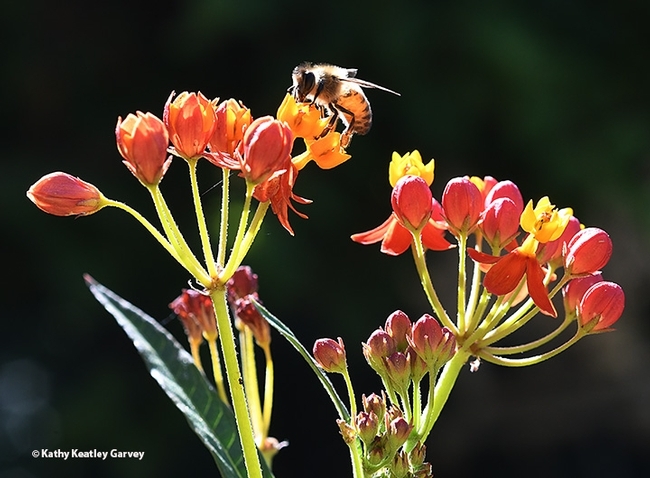
Honey bees and other pollinators frequent tropical milkweed, Asclepias curassavica. (Photo by Kathy Keatley Garvey)